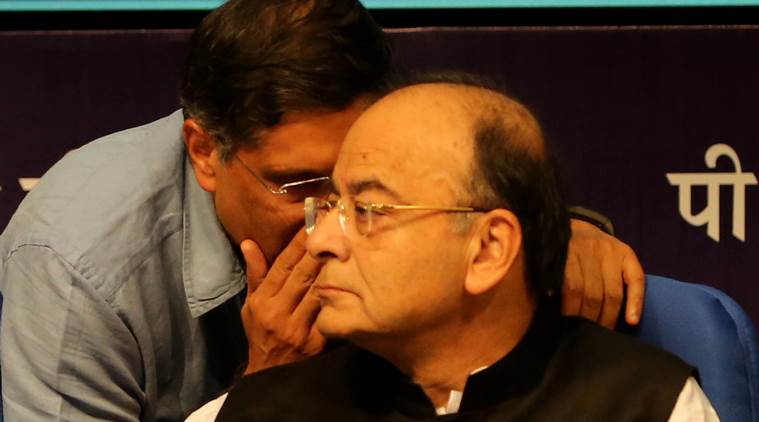Tighter is better
Loose fiscal and monetary policies pushed India to brink of crisis in 2013. Wiser policy could avert it in 2018.

Finance Minister Arun Jaitley along with Arvind Subramanian Chief Economic Adviser to the Government during a press conference. (Express Photo by Renuka Puri)
Since April, emerging markets (EMs) have been rudely shocked by the sudden reversal of capital flows without any apparent change in economic fundamentals. Many would also argue that the financial buffers in EM are much stronger today than they were before the 2013 taper tantrum. However, across all the economies that have come under pressure, namely the ones with large current account deficits and, in turn, high foreign borrowing, there has been a steady decline in policy space because of loose fiscal and, in some cases, monetary policy. Without adequate policy space, these buffers have turned ineffective.
At the risk of oversimplifying, capital inflows into EM are driven by two factors: The growth differential with developed markets (DM) and the strength of the US dollar. Higher EM-DM growth differential increases inflow, a stronger US dollar lowers it. The logic is straightforward: Investing in EM is riskier, higher growth will compensate the risk; ergo, the higher the compensation, the larger is the inflow. Similarly, a stronger dollar raises the cost of funding and therefore investors scale back investment. Since the early 2000s, much of the EM capital inflow dynamics — the steady rise in inflow until 2008, its collapse and recovery during the global financial crisis and its immediate aftermath, the relentless decline over 2010-15, the recovery from early 2016, and steep decline in the last two months — is explained by these two factors.
Starting early 2016, EM began a strong recovery powered by a synchronised global rebound. EM-DM growth differential began to widen, inflows returned, and EM outperformed DM across asset classes. The beneficiaries of the inflows were countries with large current account and fiscal deficits that offered high interest rates to compensate for these imbalances and policy uncertainties such as Argentina, Brazil, South Africa, Turkey, India.
Over this period, despite US interest rates rising every other quarter, the dollar weakened. It is not that US growth was slowing; its differential with the rest of the world (Euro Area and Japan, and EM) was narrowing. Much of the same is expected in 2018: The US would deliver above par growth, but the differential with the rest of the world would narrow. In addition, growth in the US would be driven by a rising fiscal deficit (due to unfinanced tax cuts) funded by foreign borrowing, that is, a widening current account deficit. These factors — a narrowing growth differential and widening twin deficits — would raise interest rates in the US but weaken the dollar. Convinced that global economics would follow this path, inflows into EM surged in the first quarter of 2018.
In April, the world changed. Incoming data from the Euro Area and Japan pointed to growth disappointment, but above par growth in the US. The altered dynamics forced the market to reprice US interest rates and the dollar. The consequent tightening of global financial conditions caught investors off guard. Capital outflows from EM ensued and their currencies depreciated. Most of the damage was concentrated on the high-yielders.
The past few weeks have seen some stabilisation as the repricing of US interest rates and the dollar appear to be nearing an end, much of this having to do with improved economic data emerging from the Euro Area and the ECB’s recent promise to end quantitative easing by December. However, none of the vulnerable countries are out of the woods unless the dollar turns decisively benign and policy uncertainties are resolved. And if not, then more aggressive rate hikes and further depreciation will likely follow that will cloud growth prospects, narrow the growth differential with DM, and force further capital outflows. This is the downward spiral that EM economies with macroeconomic imbalances undergo regularly. Having seen this movie play out many times, we all know how it ends.
Many will argue that these countries today have more buffers than in the past, pointing to the higher foreign exchange reserves, though they conveniently forget that foreign exchange liabilities have also risen and that there are limits to the use of reserves. More importantly, buffers have limited effectiveness if there is no policy space.
In several, if not all, vulnerable economies, the current account deficit is rising because of growing fiscal and quasi-fiscal deficits. Fiscal profligacy is, once again, restraining the space for the economies to grow without increasing foreign borrowing. Put differently, if an EM economy is to maintain or widen the growth differential with DM, it needs to grow faster, requiring more funding. If the government does not reduce its deficit to provide the additional funds, the private sector is forced to borrow more externally, that is, the current account deficit has to widen. When global financial conditions tighten, foreign investors become increasingly reluctant to provide the additional funds, afraid that the borrowing country will not be able to repay without eventual debt restructurings and large declines in stock prices or in the value of the FDI project. The way out is to tighten fiscal policy, even when it might not have been part of the problem, so that the private sector has the domestic space to grow.
In several, if not all, vulnerable economies, the current account deficit is rising because of growing fiscal and quasi-fiscal deficits. Fiscal profligacy is, once again, restraining the space for the economies to grow without increasing foreign borrowing. Put differently, if an EM economy is to maintain or widen the growth differential with DM, it needs to grow faster, requiring more funding. If the government does not reduce its deficit to provide the additional funds, the private sector is forced to borrow more externally, that is, the current account deficit has to widen. When global financial conditions tighten, foreign investors become increasingly reluctant to provide the additional funds, afraid that the borrowing country will not be able to repay without eventual debt restructurings and large declines in stock prices or in the value of the FDI project. The way out is to tighten fiscal policy, even when it might not have been part of the problem, so that the private sector has the domestic space to grow.
India is no different. Excluding asset sales, India’s overall fiscal deficit (Centre plus state) has remained virtually constant, around 7 per cent of GDP since 2013-14, despite oil price averaging over these years about half the levels reached in 2013-14. This year, again, both the Centre and state deficits are likely to be under pressure with GST collections running below the budgeted run rate. What saved India these last four years was the continued decline in private investment, which provided the excess domestic savings needed to keep the current account deficit (foreign borrowing) contained at around 1 per cent. The improvement in India’s macroeconomic imbalances over this period was largely a result of weak private activity and borrowing — the very things we collectively lament — and much less due to public sector efforts. With the higher budgeted fiscal deficit, even the hint of a recovery in private investment is raising fears of the current account deficit rising sharply. When global financial conditions were benign, it might have been possible to fund the higher borrowing relatively easily. Not any longer.
Loose fiscal and monetary policies pushed India to the brink of crisis in 2013. The taper tantrum was the trigger. If India doesn’t tighten fiscal and monetary policies early and sufficiently, then it too could be heading down the path of its peers. Thankfully, the RBI has made a start. The central bank has long been entrusted with multiple responsibilities: Delivering on the inflation target; managing government’s debt; and preserving financial stability. In the last policy review, the RBI in raising interest rates rightly chose to prioritise financial stability over the other objectives. Hopefully, it will continue to do so and not be overly influenced by short-term growth inflation dynamics or debt management issues. The year 2018 may not appear as bad as 2013, but if the dollar continues to strengthen, it could well turn out to be.
The writer is Chief Emerging Markets Economist, J P Morgan. Views are personal
For all the latest Opinion News, download Indian Express App
More From Jahangir Aziz
China’s watershed moment
Uncertain new year
Touched by Brexit
The 19th Party Congress has re-identified the ‘principal contradiction’ facing society. There will be consequences ..
US election changed global financial calculations. Emerging markets must wait and watch...
The export-led growth model needs rethinking. In India, the conversation hasn’t even begun...






































No hay comentarios:
Publicar un comentario